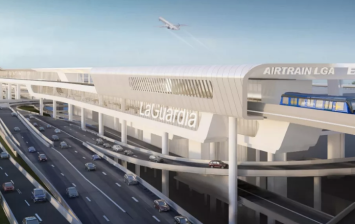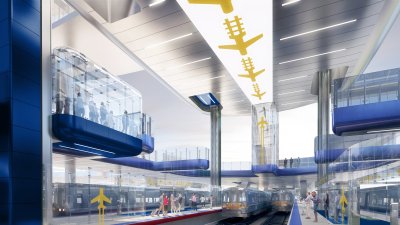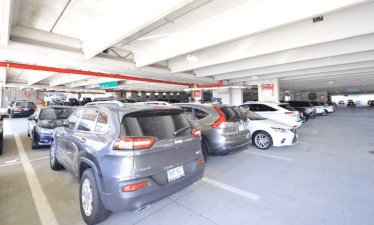OPINION: The Myth of the 30-Minute, One-Seat Ride on the LGA AirTrain

The Federal Aviation Authority is holding workshops and public hearings starting on Tuesday about the Port Authority of New York and New Jersey’s plan to build a rail link between LaGuardia Airport and the 7 train and Long Island Rail Road stations at Willets Point, about two miles to the east of the airfield. The proposal is controversial because of its route, its cost, its usefulness and its very place in a post-COVID world. Streetsblog has consistently covered the issue (archive here), but today we present multiple op-eds from various players. For more information about the virtual workshops and public hearing, click here.
Advocates for the LaGuardia AirTrain such as Gov. Cuomo and Port Authority Executive Director Rick Cotton promise a 30-minute or less connection from LaGuardia Airport to Manhattan via the AirTrain. It’s a myth.
Cuomo’s belief that this will provide a “one-seat ride” for those traveling to and from LaGuardia Airport isn’t born out by the facts. There will be significant conflicts at both the Mets Willets Point NYC Transit subway and Long Island Rail Road stations. Why would travelers with luggage and those with children attempt to squeeze onto already packed rush hour NYC Transit 7 train and Port Washington branch LIRR trains? These same trains frequently have riders standing in the aisles during rush hours. People attending New York Met games and concerts at Citi Field, US Open or other events at Arthur Ashe stadium also use this station. Others travel to Flushing Meadow Park and Queens Zoo.
Why would any LIRR riders from branches other than Port Washington want to first drive or take a taxi to a local Queens, Nassau or Suffolk County train station, then change at Jamaica and again at Woodside before transferring a third time to a Port Washington branch train before reaching the LaGuardia AirTrain? Most will use their own car, taxi, car service, Lyft or Uber for a faster direct connection to LaGuardia Airport.
Cuomo has promised frequent direct LIRR service on the Port Washington branch between Penn Station, Grand Central Terminal and Mets Willets Point station to support his $2-billion Air Train. You will need seven minutes travel time on the AirTrain to reach LIRR or the 7 train station at Willets Point. Travel time on the LIRR from that station to Penn Station is 17 minutes. Factor in up to six minutes to wait for a connection at Shea Stadium for the LIRR or the 7 train. It will probably also need 17 minutes before reaching the new LIRR East Side Access Grand Central Terminal. (Remember that the four platforms at this facility are the equivalent of 15 stories below ground. It may require five to 10 minutes just to reach street level!)
The 7 train to Manhattan is a minimum of 25 minutes via express (only runs in inbound in the morning and outbound in the evening except for major events at Shea Stadium) and 30 minutes on the local.
The LIRR will require six trains per hour in each direction to support 10-minute headways. This is necessary to fulfill his promised 30 minute travel time from LaGaurdia Airport to Midtown Manhattan. Even with implementation of Positive Train Control, it may not be possible for the Port Washington LIRR branch to accommodate these additional trains during rush hour. Off-peak service on the Port Washington LIRR branch is once every 30 minutes, so the LIRR would have to add four additional trains per hour in order to meet promised 30-minute travel time.
None of the players — Cuomo, Cotton, MTA Chairman Pat Foye or LIRR President Phil Eng — has ever revealed what the additional operating costs would be.
No one has identified the funding sources to pay for all this extra service.
It will easily be in the millions.
Are these funds included in the MTA LIRR operating budget in future years to pay for this cost? Since the Jamaica Air Train cost $7.50 each way, you have to assume it would be the same price for the LaGuardia AirTrain. LIRR peak tickets cost $10.75 and $7.75 off peak. Will the LIRR offer $4.50 same-day City Zone tickets on the weekend for AirTrain riders as well?
When you add up the costs, groups of two or more are just as likely to pool their resources to pay for a car service, taxi, Uber, or Lyft. Any of these options would provide a simple one seat ride to Manhattan. There would be no need to make another transfer at Penn Station or Grand Central Terminal via bus, subway or other mod of transportation to reach a final destination.
What will happen if the pilot Atlantic Branch southeast Queens Commuter Rail Fare Equalization program is expanded to include the Port Washington branch? Many NYC elected officials especially 2021 Mayoral candidates advocate a $2.75 LIRR fare for all local residents. This would assist those who live in two fare zones or so called transit deserts, Just imagine several thousand new riders attempting to board LIRR trains between Little Neck and Flushing. How many Nassau County residents will drive to Queens for the cheaper fares? How would the LIRR accommodate these new riders with those using the LaGuardia AirTrain?
When there are problems on the Flushing 7 train, the LIRR cross-honors subway riders at a reduced fare. Imagine several thousand more of the 66,000 daily riders who board the 7 subway at Flushing Main Street attempting to squeeze onto already crowded Port Washington LIRR trains.
There is no room to run additional trains in or out of Penn Station during rush hours using the East River tunnels with connections via the Port Washington LIRR branch. This conflicts with Cuomo’s promise to have the LIRR provide frequent service between Penn Station and Mets Willets Point LIRR Station. What about service from Grand Central Terminal once LIRR East Side Access is achieved by December, 2022? Three of the four East River tunnels run inbound during a.m. and outbound p.m. rush hours have tight spacing between trains. One tunnel is shared by the LIRR, New Jersey Transit and Amtrak for reverse train movements with equally tight spacing during rush hours. There is no Penn Station platform capacity to accommodate any additional rush hour trains. If one of the four tunnels is temporarily out of service, it results in numerous delays, cancellation and combining of trains. Imagine AirTrain riders trying to squeeze on to late or combined Port Washington branch trains hoping they will not miss their flight out of LaGuardia.
Implementation of Communication Based Train Control for the Flushing 7 subway in December, 2018 (two years late, by the way) only resulted in increasing the number of trains per hour from 27 to 29 during rush hour. NYC Transit now has no other opportunity for increasing rush hour capacity.
A one-seat ride could be accomplished by extending the N and W subway lines to LaGuardia Airport. This plan died due to local community opposition.
Only Cuomo, the Port Authority, their consultants along with labor unions and construction contractors who would benefit by this project, refuse to acknowledge the reality that a 30 minute trip is fantasy. Only they support this plan, as Streetsblog reported.
New York City is spending $200 million on a clean up project to bring back wetlands on the shore and upgrade the sewer system for Flushing Bay. Much of this work will be performed on the same waterfront shoreline as the proposed $2.05-billion LaGuardia AirTrain. How much of this environmental remediation work will have to be done over a second time due to construction of the LaGuardia Air Train?
Larry Penner is a transportation advocate, historian and writer who worked for the Federal Transit Administration Region 2 New York Office. This included the development, review, approval and oversight for billions in capital projects and programs for the MTA, NYC Transit, Long Island Rail Road, Metro North Rail Road, MTA Bus, NYC Department of Transportation along with 30 other local transit agencies.


